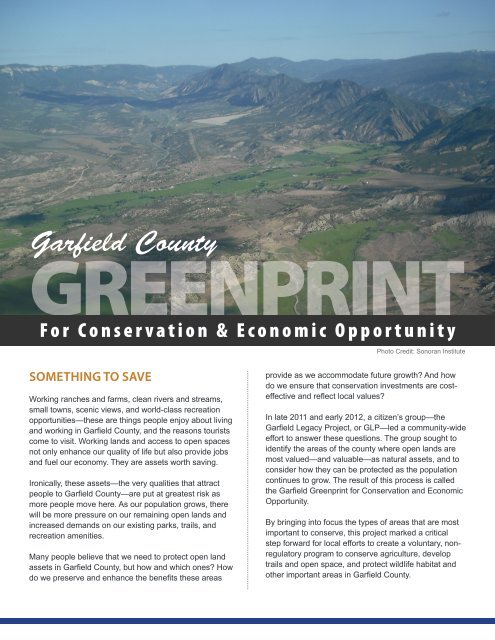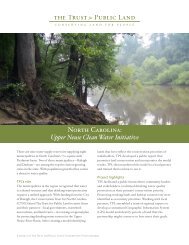Garfield County - The Trust for Public Land
Garfield County - The Trust for Public Land
Garfield County - The Trust for Public Land
Create successful ePaper yourself
Turn your PDF publications into a flip-book with our unique Google optimized e-Paper software.
<strong>Garfield</strong> <strong>County</strong><br />
GREENPRINT<br />
For Conservation & Economic Opportunity<br />
SOMETHING TO SAVE<br />
Working ranches and farms, clean rivers and streams,<br />
small towns, scenic views, and world-class recreation<br />
opportunities—these are things people enjoy about living<br />
and working in <strong>Garfield</strong> <strong>County</strong>, and the reasons tourists<br />
come to visit. Working lands and access to open spaces<br />
not only enhance our quality of life but also provide jobs<br />
and fuel our economy. <strong>The</strong>y are assets worth saving.<br />
Ironically, these assets—the very qualities that attract<br />
people to <strong>Garfield</strong> <strong>County</strong>—are put at greatest risk as<br />
more people move here. As our population grows, there<br />
will be more pressure on our remaining open lands and<br />
increased demands on our existing parks, trails, and<br />
recreation amenities.<br />
Many people believe that we need to protect open land<br />
assets in <strong>Garfield</strong> <strong>County</strong>, but how and which ones? How<br />
do we preserve and enhance the benefits these areas<br />
Photo Credit: Sonoran Institute<br />
provide as we accommodate future growth? And how<br />
do we ensure that conservation investments are costeffective<br />
and reflect local values?<br />
In late 2011 and early 2012, a citizen’s group—the<br />
<strong>Garfield</strong> Legacy Project, or GLP—led a community-wide<br />
ef<strong>for</strong>t to answer these questions. <strong>The</strong> group sought to<br />
identify the areas of the county where open lands are<br />
most valued—and valuable—as natural assets, and to<br />
consider how they can be protected as the population<br />
continues to grow. <strong>The</strong> result of this process is called<br />
the <strong>Garfield</strong> Greenprint <strong>for</strong> Conservation and Economic<br />
Opportunity.<br />
By bringing into focus the types of areas that are most<br />
important to conserve, this project marked a critical<br />
step <strong>for</strong>ward <strong>for</strong> local ef<strong>for</strong>ts to create a voluntary, nonregulatory<br />
program to conserve agriculture, develop<br />
trails and open space, and protect wildlife habitat and<br />
other important areas in <strong>Garfield</strong> <strong>County</strong>.
THE GREENPRINT<br />
A Greenprint is a visual roadmap <strong>for</strong> voluntary<br />
conservation based on local residents’ goals and<br />
priorities. It is intended to serve as a guide <strong>for</strong> voluntary<br />
land conservation with willing landowners, and ensure<br />
that future conservation investments are strategic, costeffective,<br />
and representative of community values.<br />
At the core of the 12-month <strong>Garfield</strong> Greenprint project<br />
was a series of discussions with residents about what<br />
they value about living here and what they feel is worth<br />
protecting.<br />
Once the community identified these values and<br />
conservation goals, a Steering Committee discussed<br />
and ranked them. <strong>The</strong> project’s Steering Committee was<br />
a diverse group of 60 people from all major geographies<br />
and industries in <strong>Garfield</strong> <strong>County</strong>. Using publicly<br />
available, science-based data, the Steering Committee<br />
translated the values into a series of “asset maps.”<br />
<strong>The</strong>se maps are not regulatory but are meant to provide<br />
a picture of the private lands throughout the county and<br />
within each municipality that, if conserved, would best<br />
meet <strong>Garfield</strong> <strong>County</strong>’s conservation goals.<br />
GUIDING PRINCIPLES<br />
Throughout the Greenprint process, residents provided<br />
a wide range of ideas and comments concerning land<br />
conservation. <strong>The</strong> project coordinators captured these<br />
comments and developed a set of Guiding Principles<br />
intended to help direct the project, both in terms of the<br />
planning process and the Greenprint implementation.<br />
Use conservation to create economic<br />
opportunity<br />
Reflect local needs and values<br />
Keep water on agricultural lands<br />
Provide <strong>for</strong> multiple uses and multiple<br />
benefits<br />
Conservation is voluntary<br />
Avoid incompatible uses of conserved<br />
lands<br />
Energy development and conservation<br />
can coexist<br />
Studies show that open lands programs<br />
can provide numerous economic<br />
benefits by:<br />
» Supporting agriculture and ranching<br />
industries.<br />
» Increasing the value of nearby land by<br />
5% -20%.<br />
» Drawing and retaining businesses and<br />
talent.<br />
» Supporting recreation economies.<br />
» Protecting water supplies.<br />
» Boosting tourism. <strong>Garfield</strong> <strong>County</strong>’s<br />
tourism economy supports more than<br />
3,700 jobs.<br />
THE CONSERVATION RESIDENTS<br />
CARE ABOUT<br />
Through a series of public meetings and open<br />
houses, citizen interviews, an online survey, and the<br />
participation of the Steering Committee, the Greenprint<br />
process identified the community’s seven primary<br />
conservation goals:<br />
Preserve water quality and quantity – Water<br />
is the lifeblood of the county, from sustaining wildlife<br />
and native plants, to providing a playground <strong>for</strong><br />
recreationalists of all stripes, to irrigating hay fields and<br />
beyond. Residents identified the protection and care<br />
of drinking water and surface water features as the<br />
predominate issue in the county.<br />
Conserve working ranches and farms –<br />
Residents placed a high value on the protection and<br />
sustainability of working lands in order to support<br />
the local food economy and to preserve the area’s<br />
traditional economy, scenic character, and rural way of<br />
life.<br />
Preserve and enhance recreational/tourism<br />
opportunities – Residents believe access to<br />
public lands, rivers, and streams is important to<br />
tourism and recreation. Hunting and fishing, hunting<br />
guiding, mountain biking, hiking, four-wheel driving,<br />
snowmobiling, and numerous other recreation and<br />
tourism businesses rely on access to the backcountry.
Create open land buffers around communities –<br />
<strong>The</strong> public valued having buffers between the urbanizing<br />
and rural portions of the county as a means of preserving<br />
small-town character and as a way to provide visual<br />
relief between towns. Scenery is a known economic<br />
asset.<br />
Enhance trail systems – Whether by foot, hoof, or<br />
wheel, <strong>Garfield</strong> <strong>County</strong> is home to people and tourists<br />
who get out and play. Trails, be they hard or soft,<br />
enhance our ability to be outside, get around, exercise,<br />
and introduce the next generation to the outdoors.<br />
<strong>Garfield</strong> <strong>County</strong> Combined Conservation Priorities<br />
Conservation & Economic Assets<br />
Water Resources<br />
High<br />
Moderate To High<br />
Moderate<br />
<strong>Land</strong> Assets<br />
High<br />
Moderate To High<br />
Moderate<br />
Protected <strong>Land</strong>s<br />
Park, Recreation, and Wildlife Area <strong>Land</strong>s<br />
Federally Managed <strong>Land</strong>s<br />
Conservation Easements<br />
BRINGING IT ALL TOGETHER<br />
Recognizing the relationship between open lands, quality<br />
of life, and economic development, the maps that arose<br />
from the community’s conservation goals represent the<br />
county’s most valuable open land assets.<br />
In addition to the individual asset maps, the Steering<br />
Committee produced one overall map of the most<br />
important assets. Using the results of a recent<br />
countywide public opinion poll, the Steering Committee<br />
applied weights to the conservation goals and then<br />
combined the individual maps into one map (pictured<br />
above). By showing where multiple goals could be<br />
accomplished in one place, this map highlights the areas<br />
that represent the biggest “bang <strong>for</strong> the buck” <strong>for</strong> future<br />
conservation ef<strong>for</strong>ts.<br />
0 2.5 5 10 Miles<br />
Protect wildlife habitat and native plants – <strong>The</strong><br />
county has healthy populations of mule deer, elk,<br />
bears, and many species of bird <strong>for</strong> hunters and wildlife<br />
watchers. Residents value lands that provide wildlife<br />
corridors within the region and supply important habitat<br />
<strong>for</strong> threatened and endangered plants and animals.<br />
Restore impaired waters – Some healthy<br />
rivers and streams in <strong>Garfield</strong> <strong>County</strong> have been<br />
compromised and need to be restored, whether by<br />
planting native vegetation, removing weeds (like<br />
Tamarisk and Russian Olive), stabilizing streambanks,<br />
or other activities.<br />
“As someone who has made a home<br />
in <strong>Garfield</strong> <strong>County</strong>, I think about how I<br />
want this home to be <strong>for</strong> my children and<br />
granddaughter. When I think of what has<br />
given me joy over the past 40 years, it isn’t<br />
the convenience of a new shopping center<br />
or a new house where a hayfield used<br />
to be; it’s a camp in the high-country, a<br />
walk along the river with my dogs, and the<br />
pleasure of a farmer’s market dinner with<br />
the family.”<br />
—Martha Cochran
WORKING WITH INTERESTED<br />
LANDOWNERS<br />
Many landowners recognize the benefits of protecting<br />
their land through conservation easements, whether it is<br />
because they want to maintain their agricultural land <strong>for</strong><br />
future generations, or to realize tax and estate planning<br />
benefits. <strong>The</strong> vast majority of landowners believe that<br />
conserving their land is important <strong>for</strong> many reasons: as<br />
a source of food, scenery, wildlife habitat, or as a link to<br />
Western heritage.<br />
That being said, whether they are from Carbondale<br />
or Rifle or Glenwood Springs or elsewhere in <strong>Garfield</strong><br />
<strong>County</strong>, residents want to be free to make their own<br />
decisions about their property. <strong>The</strong> Greenprint strongly<br />
respects this value and will be used only to help<br />
guide voluntary land conservation with willing, private<br />
landowners.<br />
Project Coordinators<br />
<strong>Garfield</strong> Legacy Project<br />
<strong>The</strong> <strong>Trust</strong> <strong>for</strong> <strong>Public</strong> <strong>Land</strong><br />
Sonoran Institute<br />
Partners and Funders<br />
Aspen Valley <strong>Land</strong> <strong>Trust</strong><br />
Doris Duke Charitable Foundation<br />
<strong>Garfield</strong> <strong>County</strong><br />
<strong>Garfield</strong> Legacy Project<br />
Great Outdoors Colorado<br />
Sonoran Institute<br />
<strong>The</strong> <strong>Trust</strong> <strong>for</strong> <strong>Public</strong> <strong>Land</strong><br />
<strong>The</strong> in<strong>for</strong>mation in this document does not necessarily<br />
represent the ideas or opinions of project funders<br />
WHAT THIS MEANS FOR GARFIELD<br />
COUNTY<br />
As <strong>Garfield</strong> <strong>County</strong> grows, we will need to make<br />
important decisions about the open lands assets that<br />
contribute to our quality of life and economic viability.<br />
<strong>The</strong> <strong>Garfield</strong> Greenprint <strong>for</strong> Conservation and Economic<br />
Opportunity provides a vision <strong>for</strong> strategic conservation<br />
based on local values and the best available science.<br />
Not all of the lands identified will be able to be<br />
conserved, but the Greenprint can guide local<br />
governments and future conservation partners in<br />
making well-in<strong>for</strong>med investments—through willing<br />
landowners—to conserve our natural, cultural, and<br />
recreational assets.<br />
“Good friends and ranching neighbors of mine were somewhat critical of my decision to<br />
deed restrict our ranch with conservation easements. I explained to them my thinking. First,<br />
tourism is one of our main industries; people come here to look at mountains and ranches,<br />
not subdivisions. Secondly, I am being paid to keep the ranch a ranch. How great is that?<br />
Thirdly, you can still sell it as a ranch here in the mountains of Colorado. Later, I found out that<br />
my friends who were initially skeptical of my decisions got conservation easements on their<br />
place not long after we had that discussion.”<br />
—Wendy McNulty<br />
For more in<strong>for</strong>mation, please visit:<br />
www.garfieldlegacy.org and www.tpl.org/garfield Photo Credit: Glenwood Springs Chamber Resort Association




